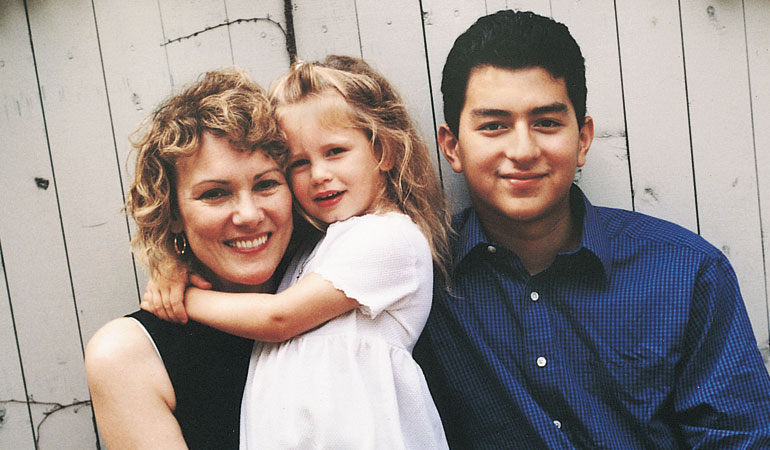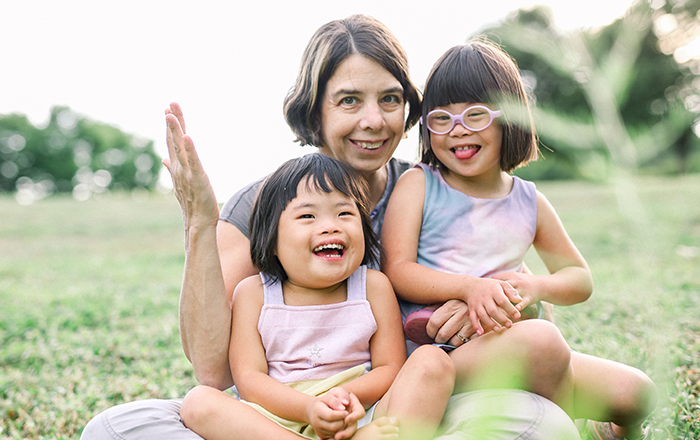Sharon Lee Puttmann, a 44-year-old English teacher, recently adopted her third daughter, a 6-year-old named Joli. Waiting at home were 16-year-old Carla, born in Guatemala, and 3-year-old Maia, adopted as a baby. Since Puttmann, who is single (as are all the parents interviewed for in this article), is raising her family on a teacher’s salary, why did she adopt not just twice but a third time — requiring a loan to do it? “I absolutely love being a mom. I’d rather be doing this than anything else in the world,” she says. However, space in Puttmann’s house is tight, and so is money. Her daughters will have to pay for college themselves. “We may not have other things, but I tell them there’s an abundance of love,” she says.
Katharine Larson, a university research scholar, embarked on motherhood in her late 40s, adopting infants, now 1 and 2-and-a-half. To do it, Larson abandoned her dream of retiring at 50, rearranged her investments, and dipped into college funds for child care. “I’ll have to work until 62 to have enough for retirement,” she concedes, “but it’s totally worth it.”
Patricia Routon adopted her first two daughters through a local agency, each at five days old. “From about age 10, I wanted to adopt. I’m divorced now, but even when I was married I wanted to adopt,” she says. An only child who missed having siblings, she always wanted at least two children. A friend of Routon’s “warned me not to have more than one,” says Routon. “With one you remain a person, but with two you become a mom.” She recently added a five-year-old Ethiopian girl to her family.
Does More Mean Less?
As more singles adopt, it is increasingly common to hear of them adopting twice and more. But adding more children to your life often means less of other things: mainly time and money. There’s less attention to career, fewer vacations, a radically changed social life, and rare access to small luxuries that may be taken for granted with one child, such as eating at a restaurant with tablecloths. And, as some say, you’ll never know what real fatigue is until you parent more than one on your own.
And mobility? Forget it. The ease of going places with one child vanishes with two. “I can take one child to the sushi bar or a grown-up function,” says Routon. “It’s not so easy with two. Inconceivable comes to mind!” But the parents in this article undertook second adoptions with eyes wide open.
To a mom (no single dads were interviewed), their “whys” were the same often cited by couples: they’d always wanted at least two children. In interracial or international adoptions, some felt strongly that their first child should have a sibling of the same or similar background, especially if the family lived in a mostly white community. Two other considerations sometimes figure for singles: They don’t want to burden one child with the sole responsibility for an aging parent, and they hope to reduce the (occasionally unhealthy) intensity that may develop between a single parent and one child.
Support is Key — Money is Not
The pressures and compromises inherent in single parenting are amplified with more than one child. While some parents described here have high-level jobs, none is truly wealthy, but the decision to adopt more than once transcended financial constraints. They took loans, worked with social services, set up child care exchanges, and accepted family support. They modified professional goals and work schedules. All economized in different ways. Many relied on emotional support from family, friends, and employers (but sometimes found far less when they announced their decision to go for child number two or three).
Ruth Whitnah was 51 when she adopted her first child, aged 17 months, from Russia. Last year she added another, who was then two. Now 53, she is waiting to travel for another child shortly; she will then have three three-year-olds-all from Russia — at home. She first adopted when the end of a marriage and the departure of a grown son left her with an empty nest twice over. While her adult stepdaughter disapproved, a “trusted counselor helped me discover my dream. She said if that is really what I want, then do it.”
Gretchen Kohl, herself adopted and raised as an only child, has adopted seven children domestically over the last 18 years. Each has a physical or developmental special need, and several came to her at the age of five and older. Kohl worked full time through her fifth adoption, when she became a full-time mom and now supports her family on adoption subsidies. A piece of advice from Kohl: “You have to know yourself enough to pick kids you can deal with. I don’t do well with kids with emotional problems, but had positive workplace experiences with disabled people and did ‘backwards research’ to see if I thought I would have liked them as children.” Kohl always had a strong support system, including her parents and dozens of cousins — her father was one of 12 — so that heading a large family felt normal. AND… she met a man — now a live-in boyfriend — in the process. (Hope springs eternal.)
Suzanne Schein’s two adoptions were made possible in large part with support from her mother. She volunteered to look after Schein’s first daughter, Emily, adopted from China, and then encouraged Schein, who is very close to her two sisters (one an identical twin), to undertake a much-wanted second adoption. “I said I’d love another daughter, but I couldn’t afford the costs,” she says. When her mother offered financial help, Schein “started the paperwork for Rebecca the following day.” Most parents rearranged their professional priorities, but they were generally older by then. Ruth Whitnah echoes a common refrain: “I’ve done the career thing and don’t need to prove anything,” she says. Lucille Cano, the mother of two boys, aged 4 and 7, whom she adopted domestically as infants, develops computer systems for a nonprofit organization. After motherhood, she says, “I reduced my traveling schedule and rarely work nights or overtime.” Cano uses au pairs for basic child care and a back-up of friends for emergencies. Although she used to work summers, Sharon Puttmann no longer does so, nor does she serve on as many committees as she used to. “I’ve gotten very good at saying no,” she says.
Adapting to a Different Standard of Living
All adjusted their standard of living. This does not mean a “lower” standard — just different. If you’re a stickler for a clean house, forget it: “My house is always a mess,” says Ruth Whitnah. “I’ve given up feeling like I need to be in control…. Fat chance!” Katherine Larson surrendered her cherished privacy for live-in child care. It reduces the chaos of getting two young children to day care and enables her to spend more time with them. She also rearranged her work schedule to do more at home.
Creative Strategies
Many single parents with at least two kids have devised creative strategies to create a support system and manage time. Lee Varon, a clinical social worker and writer who has often counseled single adoptive parents, has a rental unit in her house; her tenants agree to provide some child care in return for favorable terms. (Her children are a son, 17 — who no longer needs child care — and a daughter, 5.) Since Varon lives near Boston, there’s no shortage of students needing housing. Gretchen Kohl arranges child care exchanges so she can have free time. She networks with parents whose children’s disabilities are similar to her children’s and has adapted many of the living spaces in her “modest bungalow” to bedrooms. Her children’s ages are widely spaced so that several are on their own. Until she gave up working full-time, she exchanged the apartment above her garage for part-time child care.
Weighing the Pluses and Minuses
Are there downsides when single parents adopt more than one child? That depends on how you define downside. “The difficult part is the sibling rivalry,” confesses Lucille Cano. Seven-year-old Matthew is “very jealous of any one who gets in the way of him and his mom,” especially his four-year-old brother, Zachary. “That has been very tough,” she says. And, she adds sheepishly, “With two you cannot tell who really ‘did’ it as with one.”
The demands of several young ones can take a physical toll. “One child always seems to be awake,” notes Katharine Larson. She needed wrist surgeries from carrying her son and experienced nerve pain in her neck and back from caring for her infant daughter. Last winter, she and her children came down with the flu while her nanny was on vacation. “I couldn’t ask my mother to help for fear of exposing her, and my sister was planning her daughter’s wedding and couldn’t risk getting sick, either,” she says. Her mother left groceries at the door, “which was a godsend,” Larson reports. “But these were some of the hardest 14 days of my life.”
Be Nice to Yourself
No matter what family setup you have, you must tend to your own needs. “I try to build in one night a week for me,” says Lee Varon. “I love my kids but it’s important to be able to have a conversation with friends about something besides kids or work.” Gretchen Kohl — despite having a house full of children — always makes time for herself, drawing on her extensive support system for respite. She makes sure to have private time with her boyfriend, including taking vacations together. Sharon Lee Puttmann goes running at 4:30 every morning. Having a teenage daughter makes the difference, since Carla can tend to an emergency.
Twice as Much of Everything
Yes, adopting more than one child is a special challenge for a single parent. Perhaps it should come with a warning, courtesy of Lucille Cano: “Two is definitely harder than one. There is twice as much of everything. More fighting, more rivalry, more copying, more annoying one another. But the best is that there is twice as much love for you.”



